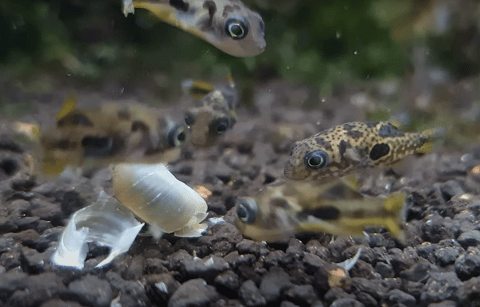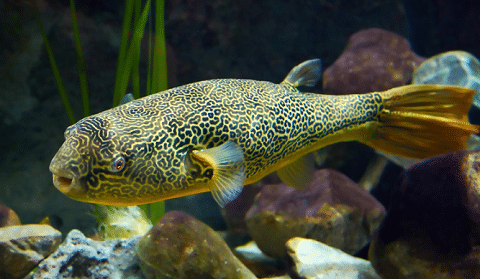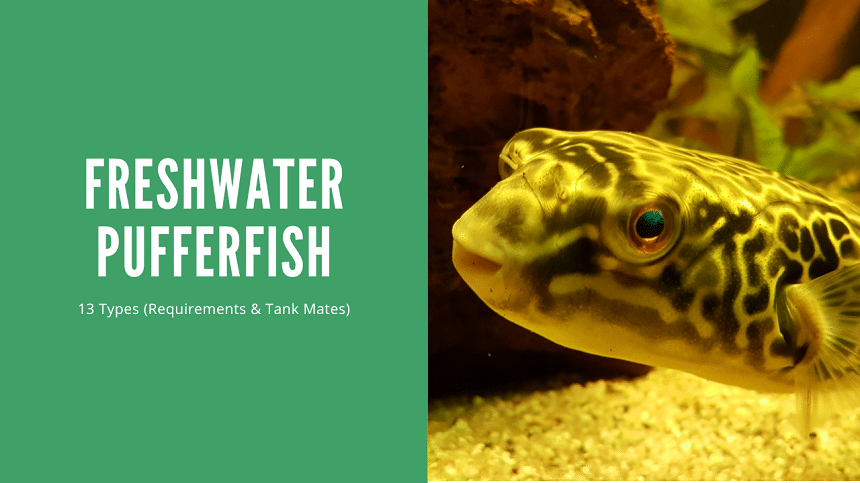Thank you for visiting! By the way… any links on this page that lead to products on Amazon and other stores/partners are affiliate links Aquarium Store Depot earns a commission if you make a purchase.
Freshwater pufferfish are some of the most interesting and entertaining fish in the aquarium hobby. Many fishkeepers are surprised to learn that these fish live outside of saltwater, and there are several awesome species available that thrive can in a regular tropical fish tank.
Puffers are not the easiest fish to keep, and some species are best left to experienced pufferfish keepers. However, with the right knowledge and planning, a freshwater puffer could easily become your new favorite fish!
Are you ready to learn about the different types of freshwater puffer fish? Then let’s get started!
Key Takeaways
- Freshwater puffer fish range from tiny nano species to real tank busters
- Most pufferfish do best in a species-only setup, although some can work in a carefully planned community tank
- Freshwater puffer fish need meaty, hard-shelled food like snails and shellfish to keep their beaks worn down
What Are They?
Puffer fish belong to the Tetraodontidae family, a group of fish that are found in fresh, brackish, and saltwater environments in many parts of the world.
These fish are called puffer fish because they have the ability to expand their body size by two or three times by sucking in water or air. Puffing up makes them look much larger than they really are, and this deters predators.
However, puffer fish have another defense if that trick fails. Although the concentration varies between species, all puffers carry a poison called tetrodotoxin in their skin. Captive fish are relatively safe, but of course, they should never be eaten or fed to pets!
Why Keep Them?
Freshwater puffer fish are beautiful animals and often have interesting patterns and bright colors. However, these fish are just as popular for their behavior as their looks.
Puffer fish are more like pets than display animals. These inquisitive fish love to interact with their owners, especially around meal times!
Freshwater puffer fish have an interesting way of moving through the water. They have fairly large tails but they generally hover around using their smaller pectoral fins. This swimming style makes them pretty slow movers, but they can be surprisingly quick when grabbing a meal.
These freshwater puffer fish generally range from semi-aggressive to full-blown killers, so they are not good fish to simply add to your tropical community aquarium. With their sharp teeth and quick bursts of speed, they can do some serious damage to their tank mates.
All in all, freshwater puffer fish are right for you if you want an interesting carnivorous pet fish with enough personality to fill its own tank!
13 Best Freshwater Puffer Fish for Tropical Aquariums
Now that you know a little more about freshwater puffer fish, let’s dive right in and meet 13 species that you can keep. We have a video from our YouTube Channel you can check out. We go into more detail in the blog post below. If you like our content, be sure to subscribe as we have no videos posted every week!
I’ve included some key information about each species and its needs, so take note of the following stats if you’re looking for your own freshwater puffer fish:
- Scientific name
- Common names
- Origin
- Adult size
- Tank size
- Temperament
- Community safe?
- pH
- Water temperature
Ready? Let’s dive right in!
1. Pea

- Scientific name: Carinotetraodon travancoricus
- Common names: Dwarf puffer fish, pygmy pufferfish
- Origin: India
- Adult size: 1 inch
- Minimum tank size: 5 gallons
- Temperament: Aggressive
- Community safe?: With caution
- pH: 6.8 – 8
- Water temperature: 72 – 82 °F
The dwarf puffer fish is an awesome little nano species that is easy to find and won’t cost more than a few dollars. These tiny fish grow to just an inch long, so you can keep a single fish in a tank as small as 5 gallons.
Dwarf puffers may be cute, but they can be mean and keeping more than one can be risky. A trio of one male and two females in a heavily planted 15-gallon is worth trying, but make sure you have a backup plan to separate your pea pufferfish if there is conflict.
2. Imitator
- Scientific name: Carinotetraodon imitator
- Common names: Dwarf Malabar puffer fish
- Origin: India
- Adult size: 1 inch
- Minimum tank size: 5 gallon
- Temperament: Aggressive
- Community safe?: With caution
- pH: 6.8 – 7.5
- Water temperature: 76 – 82°F
The imitator puffer fish is a tiny pufferfish species, very similar to the dwarf puffer fish, and has the same general care requirements. This is a rarer species that can be distinguished by its brighter yellow color and fewer spots.
3. Mbu

- Scientific name: Tetraodon mbu
- Common names: Giant puffer fish
- Origin: Central Africa
- Adult size: 20 – 30 inches
- Minimum tank size: 500 gallons
- Temperament: Aggressive
- Community safe?: With caution
- pH: 7 – 8
- Water temperature: 75 – 79°F
Unlike the previous two species, there’s nothing nano about the mbu puffer fish! This is the world’s largest puffer1, and it makes an amazing pet for dedicated and experienced fish keepers.
These huge freshwater puffer fish require a massive tank that holds hundreds of gallons of well-filtered water. They can be kept in a community tank, but avoid slow-swimming bottom dwellers that might make a tasty snack for the mighty mbu puffer.
4. Hairy
- Scientific name: Tetraodon baileyi
- Origin: Laos & Thailand, Southeast Asia
- Adult size: 5 inches
- Minimum tank size: 30 gallons
- Temperament: Aggressive
- Community safe?: No
- pH: 6.5 – 7.5
- Water temperature: 74 – 81°F
The hairy pufferfish is an awesome ambush-hunting puffer from Asia. These unique freshwater puffer fish get their name from the hair-like growths on their body that break up their outline.
Hairy puffers hang out at the bottom of the tank, just waiting for something tasty to swim or crawl by. They are not a community species and will do best in a species-only tank with a sandy substrate that they can burrow in.
5. Green Spotted

- Scientific name: Tetraodon nigroviridis
- Origin: South & Southeast Asia
- Adult size: 6 inches
- Minimum tank size: 30 gallons
- Temperament: Semi-aggressive
- Community safe?: With caution
- pH: 7.5 – 8.5
- Water temperature: 75 – 82°F
The green-spotted puffer fish is one of the best-looking species if you ask me. These adorable fish have dark spots on a yellow/green back, and a plain white belly.
The green-spotted puffer is a medium-sized species. You could keep them in a 30-gallon tank, but 55 is a better option. They are usually aggressive towards their own species except in very large aquariums.
It’s important to note that this puffer is a brackish water species. Although the young are often sold as freshwater fish, adults are going to need a slightly salty setup to really thrive.
6. Spotted Congo
- Scientific name: Tetraodon schoutedeni
- Origin: Democratic Republic of Congo
- Adult size: 4 inches
- Minimum tank size: 40 gallons
- Temperament: Semi-aggressive
- Community safe?: With caution
- pH: 6.5 – 7.5
- Water temperature: 78 – 81°F
The spotted congo puffer is the smallest of the African species, maxing out at about 4 inches. They are relatively peaceful and can live in small groups or with other peaceful fish. Just avoid any slow-swimming tankmates with long fins!
Like all puffers, these guys need great water quality and a steady supply of hard-shelled food to thrive. If you can provide that, you should have no problem keeping this awesome African species.
7. Amazon
- Scientific name: Colomesus asellus
- Common names: South American puffer fish
- Origin: Amazon River Basin, South America
- Adult size: 3 – 4 inches
- Tank size: 30 gallons
- Temperament: Semi-aggressive
- Community safe?: With caution
- pH: 5.5 – 8
- Water temperature: 75 – 80°F
The Amazon puffer is one of the few species on this list that works well in community aquariums. You can keep just one, but this species forms shoals in the wild so it will do best if kept in groups of at least six.
8. Red-Tailed Dwarf
- Scientific name: Carinotetraodon irrubesco
- Common names: Red-tailed redeye puffer fish
- Origin: Southeast Asia
- Adult size: 1.5 – 2 inches
- Minimum tank size: 15 gallons
- Temperament: Aggressive
- Community safe?: No
- pH: 6 – 7.5
- Water temperature: 68 – 82°F
The Red-tailed dwarf puffer fish (video source) is true freshwater species that lives in forest streams in Asia. These fish have really cool markings and bright red eyes.
Like other puffers, these guys will nip slow-moving fish, so choosing tank mates should be done carefully. They can be kept in small groups if you have enough plants and hardscape to break up their line of sight, but try to add just one male and a few females.
9. Fahaka
- Scientific name: Tetraodon lineatus
- Common names: Globe fish, Nile puffer fish
- Origin: Central & North Africa
- Adult size: up to 17 inches
- Tank size: 100-150 gallons
- Temperament: Highly aggressive
- Community safe?: No
- pH: 6.5 – 7.5
- Water temperature: 75 – 79°F
The Fahaka puffer fish (video source) is another giant species from Africa. They require a hard-shelled diet of snails, crab legs, and whole mussels and clams to keep their sharp beaks worn down.
The fahaka puffer has awesome markings and makes a great ‘wet pet’ for a species-only tank. However, these fish are extremely aggressive, even toward their own species, so avoid adding any tank mates.
10. Golden
- Scientific name: Auriglobus silus
- Common names: Gold green puffer fish, avocado puffer fish, bronze puffer fish
- Origin: Southeast Asia
- Adult size: 4 inches
- Minimum tank size: 20-30 gallons
- Temperament: Highly aggressive
- Community safe?: No
- pH: 6 – 7.8
- Water temperature: 74 – 80°F
The golden puffer is still pretty rare in the hobby, but these freshwater puffer fish definitely have great looks! They are said to be very aggressive toward other fish species and even their own kind, so it’s easiest to give each specimen its own fish tank.
11. Ocellated
- Scientific name: Tetraodon cucutia/ Leiodon cutcutia
- Origin: South & Southeast Asia
- Adult size: 6 inches
- Minimum tank size: 20 gallons
- Temperament: Aggressive
- Community safe?: No
- pH: 6.5 – 7.5
- Water temperature: 75 – 82°F
The ocellated puffer fish is another rare species that can make a great pet. This fish will do best in a well-planted tank with some caves and hiding places. A sandy substrate and moderate water flow will help to recreate their natural habitat.
12. Arrowhead
- Scientific name: Tetraodon suvattii
- Common names: Pignose puffer fish
- Origin: Laos & Thailand
- Adult size: 6 inches
- Minimum tank size: 20 gallons
- Temperament: Aggressive
- Community safe?: No
- pH: 6.5 – 7.5
- Water temperature: 72 – 79 °F
The arrowhead puffer fish is an ambush predator that stays down on the substrate. These fish are highly aggressive and will eat any smaller fish that fits in their mouth. They will also bite chunks out of larger freshwater fish, so they are only really suitable for a species-only tank.
Arrowhead puffers are pretty inactive, so they don’t need a large tank. However, they do need a deep layer (2 – 3 inches) of a fine substrate to bury into.
13. Crested
- Scientific name: Carinoteraodon lorteti
- Common names: Red-eyed puffer
- Origin: Southeast Asia
- Adult size: 2 inches
- Minimum tank size: 15 gallons
- Temperament: Semi-aggressive
- Community safe?: No
- pH: 5 – 7.5
- Water temperature: 75 – 82 °F
The crested puffer fish is another dwarf puffer fish that is suitable for smaller fish tanks. This species looks similar to the red-tailed dwarf puffer, although it grows a little larger.
Keep these interesting puffer fish in a well-planted aquarium that mimics their natural habitat. They should not be kept with other fish species, although experienced aquarists may have success keeping a small group in a large tank with dense vegetation and plenty of hardscape to create multiple territories.
Tank Setup
Most types of pufferfish do not have any unusual tank requirements, although giant African species like the mbu pufferfish and the fahaka pufferfish need huge tanks.
Puffers are messy feeders so regular water changes and high-quality filtration are a must. These fish do not do well in high nitrate water parameters, so you’ll need to test your water frequently at first to work out a good maintenance routine.
Freshwater puffers are tropical fish, which means you’re going to need a heater to keep them comfortable. Choose a model that matches your tank size, and add a thermometer to make monitoring the temperature easier.
It might not look like it, but some puffers are adapted to high water flow. Those species will appreciate a powerhead or two to recreate their natural river habitat, but make sure there are some sheltered spots where they can rest and relax.
All freshwater puffer fish types will benefit from live plants, but the larger species can be hard on plants, so they are not the ideal choice for a prize-winning aquascape.
Grow hardy aquatic plants like Java ferns and fast-growing stem plants like limnophila and anacharis to improve your water quality and add more structure to your fish’s home.
Feeding
Pufferfish have specialized diets, and they will not eat regular fish food like flakes and pellets. They are carnivores, and their specialized beaks allow them to feed on some pretty tough meals!
In fact, these tooth-like structures grow continuously, so puffers need a regular supply of hard-shelled food to keep their teeth growth in check.
Live snails are the ideal food for most puffers, and maintaining a steady supply can be tricky. The best way is to grow your own snails in a separate tank or container. Ideal snails for this are pond, bladder, and ramshorn snails. Avoid Malaysian trumpet snails as their shell is just too hard.
The large species require shellfish like clams, and keeping them fed can get expensive. Factor this in before taking on the responsibility- these freshwater puffer fish can live for many years!
In general, freshwater pufferfish can be fed the following live and frozen food:
- Frozen bloodworms
- Frozen brine shrimp
- Glass/ghost shrimp
- Mosquito larvae
- Freeze-dried mealworms
- Freeze-dried krill
- Whitebait fish for the larger species
This frozen food pack contains 4 types of formulas in one package. A great overall package for freshwater fish
Feed your puffers two or three times per day, but be sure to remove any uneaten food before it can spoil in your aquarium.
Tank Mates
Many readers are probably wondering which tank mates work with pufferfish, and the answer is relatively few. Most puffers are naturally aggressive creatures, and their sharp beaks do serious damage to other fish.
It’s not impossible to keep other fish with freshwater puffers, but the easiest option will be a species-only setup in most cases. Generally speaking, the best tank mates will be other larger fish that are not shy to defend themselves.
It’s also possible to keep small, fast-moving fish species as tank mates, but just know that larger puffers will eat them if they can catch them.
Tank size matters too, and the larger your tank, the less risk you run of aggression. If you really want to add puffer fish to a community aquarium, choose the more peaceful species like the South American Puffer.
Health and Disease
Freshwater puffer fish are generally hardy to a range of water parameters, but they all require excellent water quality. Avoid overfeeding their tank, and make sure you perform regular water changes on your fish tank to keep nitrates down.
These fish should only be added to mature, cycled aquariums. Poor water quality causes stress in freshwater puffer fish and opens them up to a variety of illnesses.
Stress and injuries from fighting with other puffers are also common causes of illness, so choosing appropriate tank mates and setting up their tanks correctly is so important.
Many freshwater pufferfish are wild-caught and arrive at your local fish store in pretty poor condition, often with loads of internal parasites. Quarantine your fish before adding them to a tank with any other fish, and consider deworming as an extra precaution.
FAQs
Are Puffers Easy To Keep?
Puffers are not a good choice for beginner fish keepers. These guys have a specialized diet, and usually do not get along very well with other fish. However, aquarists that have kept fish for a few years should have no problem caring for these fascinating creatures if they are willing to provide the right food and maintenance.
Can They Live With Other Fish?
Pufferfish can live with other fish species, but there’s a high chance of fin nipping and other aggressive behaviors if you don’t choose the right tank mates. Species like the South American puffer get along great with many freshwater fish, but others like the Fahaka puffer are extremely territorial and aggressive.
Are They Good Pets?
Pufferfish are well known for being great ‘wet pets’. These fish are naturally inquisitive and highly interactive with their owners. However, keeping them happy and healthy requires more dedication than many air-breathing pets.
Are these fish species aggressive?
Freshwater puffer fish temperaments vary between species and even individuals. They are generally semi-aggressive or aggressive and they often bite other fish and even other members of their own species.
How Big Do They Get?
Freshwater puffer fish range in size from the tiny dwarf puffer and imitator puffer fish at an inch long to the massive mbu puffer fish that grows to 30 inches. There are many species that grow to just a few inches, and these are great for a mid-size aquarium.
Final Thoughts
Pufferfish are rockstars in the fishkeeping world. Their fascinating behaviors and larger-than-life personalities make them a great choice for more experienced fish keepers who want an exotic pet.
Do you have a favorite freshwater puffer fish species? Share your opinion below!
- About the Author
- Latest Posts
I’m thrilled that you found Aquarium Store Depot! Here you’ll find information on fish, aquariums, and all things aquatics related. I’m a hobbyist (being doing this since I was 11) and here to help other hobbyists thrive with their aquariums! I adhere to a high quality Editorial Process and Review products with real life field usage and practical analysis.






